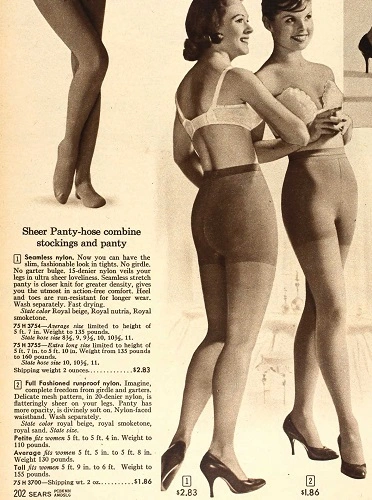
Pantyhose from Sears, Roebuck. 1960.
The Pantyhose Revolution and Supermarket Stockings
Further reading: I am indebted to this excellent article about the history of L’Eggs and pantyhose in general by Jake Rossen at Mentalfloss. For the story of how pantyhose were invented, see this article in Smithsonian.
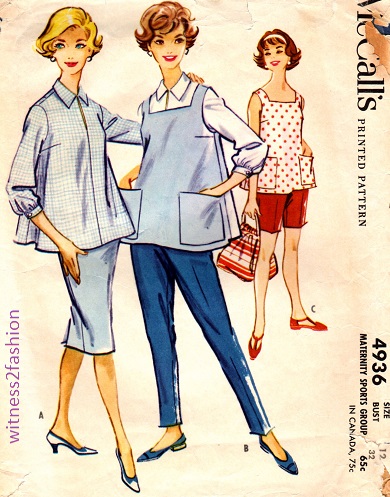
1959: McCall 4936, maternity pattern. According to Smithsonian, panty hose were invented because pregnant women found the garter belt or girdle too uncomfortable.
Pantyhose (sheer, stretch tights) were available in 1959, but not in all markets, and not in all sizes. There wasn’t much demand for them, because skirt hems were still mid-calf in the late fifties, so the thick stocking tops and garters we wore were not likely to show.

Dresses this long hid the tops of our stockings and “garter bumps” quite adequately. No need for pantyhose.
Also, really stretchy stockings didn’t exist yet.

Seamless stretch nylon stockings from Sears; Spring 1958.
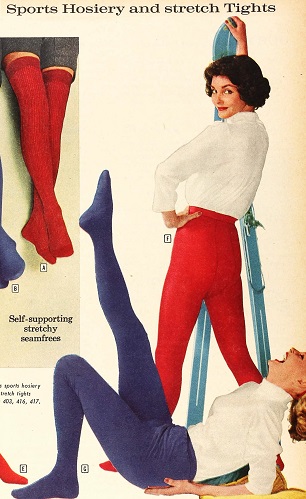
Opaque tights from Sears, Fall 1959 catalog.

Opaque tights from Sears, Fall 1959 catalog. Popular for winter sports and dance classes.
Opaque tights were available before 1959, but for most women of my generation (and those before) wearing sheer stockings with seams up the back marked the beginning of adulthood. In 1958, I was in eighth grade, and “dress up” clothing suddenly included seamed stockings (held up by a garter belt) and shoes with “high” heels.
If you were born in the 1960s or later, you may not believe how hard it was to buy stockings in the 1950s (and earlier.)
1) Most stores were not open on Sundays. In a country where most citizens were nominally Christian, Sunday was the official Sabbath, and most businesses (except for essential services like hospitals) did not buy or sell products or require employees to work on the Sabbath. Buying or selling on the Sabbath was generally against the law. Saturday had been the “market” day for centuries; weekdays were also shopping days, but not as they are now because….
2) Even in big cities, stores were not open after 5:30 or 6 p.m. “Designated shopping nite” was a very Big Deal in my childhood circa 1950 when all the major department and clothing stores in downtown San Francisco agreed to stay open until 8 p.m. — every Thursday night. (That’s right, they were open late once a week.)
Working women might have a chance to shop during their lunch break, if they worked near the stores. But a run in your last pair of stockings was a small crisis: When and where could you buy new ones?
“It was 1968, and the recently-appointed president of Hanes Hosiery Mill Co. observed a growing number of pantyhose customers were grabbing cheap stockings at grocery stores for the sake of convenience. While a woman might shop for food multiple times a week, she would likely only head to a department store once every month or two. Rather than wait, she would purchase undergarments when it was most convenient.” — Jake Rossen
When grocery stores and supermarkets began staying open at night, and they began to sell hosiery, the lives of working women took a turn for the better. This was mostly possible because improved technology gave us really stretchy stockings and tights.
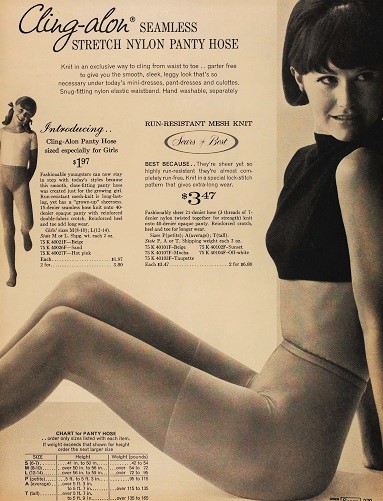
Cling-alon seamless stretch pantyhose from Sears really were stretchy: only three women’s sizes were needed.
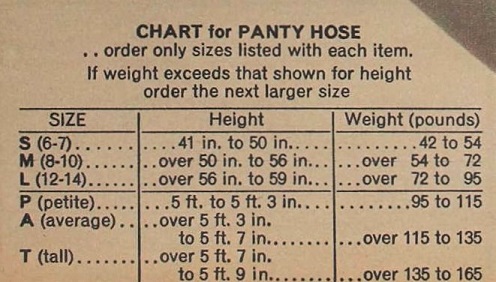
Cling-alon size chart, Sears, 1968. The women’s sizes are Petite, Average, and Tall. (The sizes at top are for girls.)
Improved stretch meant that stores no longer had to carry stockings in eighteen sizes.
Companies like Hanes made L’Eggs pantyhose specifically packaged to be sold in supermarkets. The improved stretch meant you no longer needed to sell stockings in seven sizes and four lengths. Basic L’Eggs came in just four sizes, but they fit a really big range of heights and weights. Stores were happy that a display of the full range of L’Eggs colors and sizes took up less shelf space than a display of canned olives or jelly. And working women like me could pick them up any night on the way home from work! No more Saturday trips to a department store. No more panicky mornings when I got a run in my last pair of hose.
Cotton Crotch Introduced
One problem: women who adopted the new stretch-nylon pantyhose soon began advising their friends that the nylon did not let moisture evaporate as silk or cotton underwear did. We advised each other to wear cotton briefs under nylon pantyhose to avoid unpleasant rashes and worse. Soon the manufacturers figured it out, and began making pantyhose with “cotton crotch” proudly specified on the package labels.
Thigh Bulge and Garter Bumps Eliminated
Pantyhose did eliminate a problem for women whose legs were not slim and muscular: with the old stocking suspended from one garter in front and one in back, the stocking top would sag, leaving an unpleasant bulge of flesh at the top.

Stocking tops sag at the sides in this illustration from 1930.
This model has lovely legs, but you can see how the stocking top is curving downward at the inside of the thigh. For women who didn’t have slim, firm thighs, the flesh bulged out over the stocking tops. In hot weather the bulges rubbed together, which was especially unpleasant.
Also, the garters themselves had a rubbery part that went inside the stocking, and a metal part that went outside the stocking. 
When you sat, the metal dug into your leg at the back, and the rubber part created a bump in front that was visible through light-weight dress fabrics.

Garters could be purchased separately and attached to elastic loops on the girdle.

The metal garter was detachable and inserted through these loops.
With pantyhose: Bliss! — no more garter belts or panty-girdles. And no bulges.

I remember when “silicon garters” on separate stockings became a thing in Europe in the 1980s. The silicon was supposed to adhere to your leg and keep your stocking up. I have heavy thighs so they never worked for me. As I walked I could feel them start to twist and creep down my leg. Maybe they didn’t work for anyone, as the fad didn’t last very long!
Back in the day, in my little Iowa town the “blue laws” were enforced, and yet there was one supermarket that was open on Sundays. They were usually empty, though. Going in for a carton of milk was an eerie experience. Then came the town’s first gas station/convenience store that was open (you guessed it) from 7 to 11! They were open on Sundays too, because of the gas station.
I think they still use silicone. A friend who was a dancer and gym teacher wore them and loved them. On my fat thighs, no way! My new medical compression stockings (with silicone at top) also roll down and turn into a near-tourniquet. I actually gave my M.D. a lesson on stockings, tights, and leggings for patients who don’t have firm thighs: don’t automatically call them “stockings” because there are alternatives. (Sadly, getting into a pair of compression tights or leggings is much harder!)
I remember the liberation of panty hose!
I have always wondered how stockings with garters didn’t look and feel awful on larger thighs, and now I know! They did!
They did indeed. The garter belts with just two suspenders per leg — one in front and one in back — were the worst. Garter belts with six suspenders (three per leg) helped a little, but I recently checked medical supply houses and they don’t seem to carry them!
6 or 8 is essential. You can get them from retro underwear makers, sometimes vintage shops suddenly sell them, too.
I remember the silicon garters stockings that Anna mentioned too, I never liked them. I was always afraid that my stockings would end up around my ankles while walking on the street! Our stores here in Belgium are closed at 6, only supermarkets are open until 8 and on Fridays until 9 (not now with the virus crisis, they close earlier now).
Salut, les belges! We just finished our 3rd week of lockdown here in Spain and they are talking about extending it to the end of May. I can’t go stir crazy yet, though…because I’ll have far too many days to be crazy in. Older folks like us are not meant to go out unless it’s to the doctor or pharmacy. One of my friends does our shopping. Even as an introvert, this is not being fun.
Bon courage a tous.
We’re on our 5th week of staying in in San Francisco, CA. Grateful for grocery delivery services and good neighbors (whom we talk to at a distance across the fences.) This is hitting working people and the self-employed very hard, and I feel for them. Not knowing how they’re going to feed their children…. No wonder that bags of rice and beans were stripped from grocery shelves early on. It’s a good time for those who are fortunate to support local food banks. Kudos to the courage of all medical and emergency personnel — and other ordinary people doing extraordinary service.
Hello Anna in Spain! Thinking of all of you, let us hope that all is going to go better soon. Un abrazo!
I join you in wishing well to folks from all over the world. This virus is a terrible reminder that we share one, fragile planet and we are all equally vulnerable and interdependent.
This is a marvelous, CRAMMED article. The wearablility details of clothes are often left out in the broader fashion and couture histories, and the yummy details about garters (and I thank my mother for forbidding me to wear them, when I did later OW) and shopping hours just make this one of your best.Which is saying a lot.
Thank you! I try not to blather on too much, but I did want this blog to include personal memories of wearing the clothes, especially from the fifties and sixties.
What were the parts of the garter attachment called? I’m writing a character in 1961 and I was thinking the rubber knobby thing that fits into the metal should be digging into the backs of her thighs at a party but how to describe them quickly so the whole scene isn’t about how she holds up her stockings?
I was in college from 1962 to 1966, and you are right about the garter clasp digging into the back of your legs when you sat in a hard chair. But the bulging, rubbery part faced out, creating a telltale bump on each thigh in fitted skirts, while the metal part of the clasp was what left a red dent in the backs of both legs. Sally Edelstein writes a great blog called Envisioning the American Dream, which features vintage ads and illustrations from her collection (she’s also a collage artist.) Visit https://envisioningtheamericandream.com/tag/girdles/ (at least three lavishly illustrated blogs on the topic.) Also interesting to a novelist might be her series of blogs on what happened to Rosie the Riveter after she was pushed out of the workforce and back into the “Happy Homemaker” role in the late forties and 1950s, as shown through American advertisements.